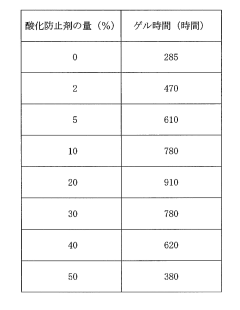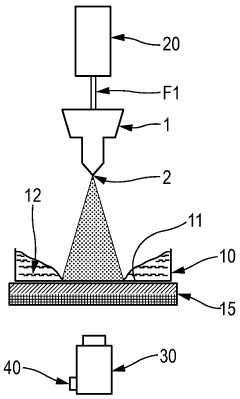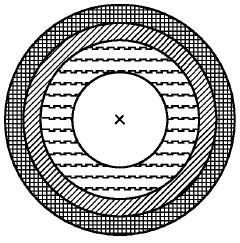How to Design Ferrofluid Systems for Improved Manufacturing Quality?
JUL 9, 20259 MIN READ
Generate Your Research Report Instantly with AI Agent
Patsnap Eureka helps you evaluate technical feasibility & market potential.
Ferrofluid Tech Evolution
Ferrofluid technology has undergone significant evolution since its inception in the 1960s. Initially developed by NASA for rocket fuel management in zero gravity, ferrofluids have found diverse applications in manufacturing and beyond. The technological progression can be traced through several key phases, each marked by advancements in material science and engineering.
In the early stages, ferrofluid development focused on improving stability and magnetic responsiveness. Scientists worked on optimizing the composition of magnetic nanoparticles and carrier fluids to enhance performance. This period saw the introduction of surfactants to prevent particle agglomeration, a crucial step in maintaining the fluid's properties over time.
The 1980s and 1990s witnessed a surge in research on ferrofluid applications in mechanical engineering. Innovations in seal design for rotating shafts emerged, utilizing ferrofluids to create dynamic, zero-leakage seals. This technology found its way into hard disk drives, significantly improving their reliability and capacity.
As manufacturing processes became more sophisticated, the role of ferrofluids in quality control expanded. The early 2000s saw the development of ferrofluid-based sensors and actuators, capable of detecting minute vibrations and providing precise control in manufacturing environments. These advancements led to improved product quality and reduced defects in various industries.
Recent years have seen a focus on nano-scale engineering of ferrofluids. Researchers have developed methods to fine-tune the magnetic properties of individual nanoparticles, allowing for more precise control over fluid behavior. This has opened up new possibilities in areas such as targeted drug delivery and advanced cooling systems for electronics.
The integration of ferrofluids with smart materials and systems represents the latest frontier. Adaptive structures that can change shape or properties in response to magnetic fields are being explored for applications in robotics and advanced manufacturing. These developments are paving the way for more flexible and responsive production systems.
Throughout this evolution, the core challenge has remained consistent: balancing the magnetic properties of the fluid with its rheological characteristics. Advances in computational modeling and simulation have played a crucial role in optimizing ferrofluid formulations for specific applications, allowing for rapid prototyping and testing of new designs.
As we look to the future, the evolution of ferrofluid technology is likely to continue along the path of increased precision and control. The ability to manipulate matter at the nanoscale promises to unlock new capabilities in manufacturing, potentially revolutionizing quality control and process optimization across various industries.
In the early stages, ferrofluid development focused on improving stability and magnetic responsiveness. Scientists worked on optimizing the composition of magnetic nanoparticles and carrier fluids to enhance performance. This period saw the introduction of surfactants to prevent particle agglomeration, a crucial step in maintaining the fluid's properties over time.
The 1980s and 1990s witnessed a surge in research on ferrofluid applications in mechanical engineering. Innovations in seal design for rotating shafts emerged, utilizing ferrofluids to create dynamic, zero-leakage seals. This technology found its way into hard disk drives, significantly improving their reliability and capacity.
As manufacturing processes became more sophisticated, the role of ferrofluids in quality control expanded. The early 2000s saw the development of ferrofluid-based sensors and actuators, capable of detecting minute vibrations and providing precise control in manufacturing environments. These advancements led to improved product quality and reduced defects in various industries.
Recent years have seen a focus on nano-scale engineering of ferrofluids. Researchers have developed methods to fine-tune the magnetic properties of individual nanoparticles, allowing for more precise control over fluid behavior. This has opened up new possibilities in areas such as targeted drug delivery and advanced cooling systems for electronics.
The integration of ferrofluids with smart materials and systems represents the latest frontier. Adaptive structures that can change shape or properties in response to magnetic fields are being explored for applications in robotics and advanced manufacturing. These developments are paving the way for more flexible and responsive production systems.
Throughout this evolution, the core challenge has remained consistent: balancing the magnetic properties of the fluid with its rheological characteristics. Advances in computational modeling and simulation have played a crucial role in optimizing ferrofluid formulations for specific applications, allowing for rapid prototyping and testing of new designs.
As we look to the future, the evolution of ferrofluid technology is likely to continue along the path of increased precision and control. The ability to manipulate matter at the nanoscale promises to unlock new capabilities in manufacturing, potentially revolutionizing quality control and process optimization across various industries.
Manufacturing Quality Needs
The manufacturing industry is constantly seeking ways to enhance product quality, reduce defects, and improve overall efficiency. In recent years, the integration of ferrofluid systems has emerged as a promising solution to address these challenges. Ferrofluids, which are colloidal liquids containing magnetic nanoparticles, offer unique properties that can be harnessed to improve various aspects of manufacturing processes.
One of the primary quality needs in manufacturing is precision control. Ferrofluid systems can provide enhanced precision in machining operations, such as cutting, grinding, and polishing. By utilizing the magnetic properties of ferrofluids, manufacturers can achieve more accurate tool positioning and better control over cutting forces, resulting in improved surface finish and dimensional accuracy of manufactured parts.
Another critical aspect of manufacturing quality is thermal management. Ferrofluids have excellent heat transfer properties, making them ideal for cooling applications in manufacturing processes. By incorporating ferrofluid-based cooling systems, manufacturers can maintain optimal operating temperatures for machinery and equipment, reducing thermal-induced errors and extending the lifespan of critical components.
Vibration control is another area where ferrofluid systems can significantly contribute to manufacturing quality. Excessive vibrations in machinery can lead to poor surface finish, reduced tool life, and increased wear on equipment. Ferrofluid-based damping systems can effectively absorb and dissipate vibrations, resulting in smoother operation and improved product quality.
In the realm of precision assembly, ferrofluids can be used to create adaptive sealing solutions. These magnetic liquid seals can conform to complex geometries and provide excellent sealing performance under dynamic conditions, addressing the need for reliable and efficient sealing in manufacturing processes.
Furthermore, ferrofluid systems can enhance quality control and inspection processes. By incorporating ferrofluid-based sensors and actuators, manufacturers can achieve more accurate and responsive feedback systems, enabling real-time monitoring and adjustment of manufacturing parameters to maintain consistent product quality.
The need for improved surface finishing is also addressed by ferrofluid systems. Magnetic field-assisted polishing techniques using ferrofluids can achieve ultra-smooth surfaces on complex geometries, meeting the increasing demands for high-quality finishes in industries such as optics and semiconductors.
As manufacturing processes become more automated, the demand for advanced fluid handling and control systems grows. Ferrofluids offer unique capabilities in this area, enabling precise control of fluid flow and distribution in various manufacturing applications, from coating processes to material transport systems.
One of the primary quality needs in manufacturing is precision control. Ferrofluid systems can provide enhanced precision in machining operations, such as cutting, grinding, and polishing. By utilizing the magnetic properties of ferrofluids, manufacturers can achieve more accurate tool positioning and better control over cutting forces, resulting in improved surface finish and dimensional accuracy of manufactured parts.
Another critical aspect of manufacturing quality is thermal management. Ferrofluids have excellent heat transfer properties, making them ideal for cooling applications in manufacturing processes. By incorporating ferrofluid-based cooling systems, manufacturers can maintain optimal operating temperatures for machinery and equipment, reducing thermal-induced errors and extending the lifespan of critical components.
Vibration control is another area where ferrofluid systems can significantly contribute to manufacturing quality. Excessive vibrations in machinery can lead to poor surface finish, reduced tool life, and increased wear on equipment. Ferrofluid-based damping systems can effectively absorb and dissipate vibrations, resulting in smoother operation and improved product quality.
In the realm of precision assembly, ferrofluids can be used to create adaptive sealing solutions. These magnetic liquid seals can conform to complex geometries and provide excellent sealing performance under dynamic conditions, addressing the need for reliable and efficient sealing in manufacturing processes.
Furthermore, ferrofluid systems can enhance quality control and inspection processes. By incorporating ferrofluid-based sensors and actuators, manufacturers can achieve more accurate and responsive feedback systems, enabling real-time monitoring and adjustment of manufacturing parameters to maintain consistent product quality.
The need for improved surface finishing is also addressed by ferrofluid systems. Magnetic field-assisted polishing techniques using ferrofluids can achieve ultra-smooth surfaces on complex geometries, meeting the increasing demands for high-quality finishes in industries such as optics and semiconductors.
As manufacturing processes become more automated, the demand for advanced fluid handling and control systems grows. Ferrofluids offer unique capabilities in this area, enabling precise control of fluid flow and distribution in various manufacturing applications, from coating processes to material transport systems.
Ferrofluid System Challenges
Ferrofluid systems present several significant challenges in the context of improving manufacturing quality. One of the primary issues is maintaining the stability of the ferrofluid suspension over extended periods. The magnetic nanoparticles in ferrofluids tend to agglomerate or settle out of the carrier fluid, leading to inconsistent properties and reduced performance. This instability can result in variations in the magnetic response and fluid behavior, compromising the precision and reliability of manufacturing processes that rely on ferrofluids.
Another critical challenge is controlling the viscosity and flow characteristics of ferrofluids under varying magnetic field strengths. The complex rheological behavior of ferrofluids, which changes dynamically with applied magnetic fields, makes it difficult to predict and manage fluid flow in manufacturing applications. This unpredictability can lead to inconsistencies in coating thickness, seal integrity, or damping performance, depending on the specific use case.
Temperature sensitivity poses yet another hurdle in ferrofluid system design. Many manufacturing processes involve temperature fluctuations, which can significantly affect the properties of ferrofluids. Changes in temperature can alter the viscosity, magnetic susceptibility, and overall stability of the fluid, potentially leading to performance degradation or system failure if not properly accounted for in the design.
The interaction between ferrofluids and other materials used in manufacturing equipment is also a concern. Ferrofluids may cause corrosion or degradation of certain materials, particularly in sealing applications or when in contact with sensitive components. This necessitates careful material selection and compatibility testing to ensure long-term reliability and prevent contamination of manufactured products.
Scaling up ferrofluid systems for industrial manufacturing presents its own set of challenges. Maintaining uniform properties and behavior across larger volumes of ferrofluid is difficult, and ensuring consistent performance in scaled-up systems requires advanced engineering and quality control measures. Additionally, the cost of producing large quantities of high-quality ferrofluids can be prohibitive for some manufacturing applications.
Lastly, the environmental and health implications of working with ferrofluids in manufacturing settings must be addressed. While generally considered safe, the long-term effects of exposure to ferrofluid nanoparticles are not fully understood. Implementing proper handling procedures, containment systems, and disposal methods is crucial to mitigate potential risks to workers and the environment.
Another critical challenge is controlling the viscosity and flow characteristics of ferrofluids under varying magnetic field strengths. The complex rheological behavior of ferrofluids, which changes dynamically with applied magnetic fields, makes it difficult to predict and manage fluid flow in manufacturing applications. This unpredictability can lead to inconsistencies in coating thickness, seal integrity, or damping performance, depending on the specific use case.
Temperature sensitivity poses yet another hurdle in ferrofluid system design. Many manufacturing processes involve temperature fluctuations, which can significantly affect the properties of ferrofluids. Changes in temperature can alter the viscosity, magnetic susceptibility, and overall stability of the fluid, potentially leading to performance degradation or system failure if not properly accounted for in the design.
The interaction between ferrofluids and other materials used in manufacturing equipment is also a concern. Ferrofluids may cause corrosion or degradation of certain materials, particularly in sealing applications or when in contact with sensitive components. This necessitates careful material selection and compatibility testing to ensure long-term reliability and prevent contamination of manufactured products.
Scaling up ferrofluid systems for industrial manufacturing presents its own set of challenges. Maintaining uniform properties and behavior across larger volumes of ferrofluid is difficult, and ensuring consistent performance in scaled-up systems requires advanced engineering and quality control measures. Additionally, the cost of producing large quantities of high-quality ferrofluids can be prohibitive for some manufacturing applications.
Lastly, the environmental and health implications of working with ferrofluids in manufacturing settings must be addressed. While generally considered safe, the long-term effects of exposure to ferrofluid nanoparticles are not fully understood. Implementing proper handling procedures, containment systems, and disposal methods is crucial to mitigate potential risks to workers and the environment.
Current Ferrofluid Solutions
01 Composition and preparation of ferrofluids
Ferrofluids are colloidal suspensions of magnetic nanoparticles in a carrier fluid. The manufacturing quality of ferrofluid systems depends on the precise composition and preparation methods. This includes selecting appropriate magnetic materials, carrier fluids, and surfactants to ensure stability and desired magnetic properties. The process may involve chemical precipitation, grinding, or thermal decomposition methods to produce uniform nanoparticles.- Composition and preparation of ferrofluids: The manufacturing quality of ferrofluid systems is heavily dependent on the composition and preparation methods. This includes the selection of appropriate magnetic particles, carrier fluids, and surfactants. The process often involves precise control of particle size distribution, stability, and magnetic properties to ensure optimal performance in various applications.
- Quality control and testing methods: Ensuring manufacturing quality in ferrofluid systems requires rigorous quality control and testing methods. This may include techniques such as magnetic property measurements, rheological testing, and stability assessments. Advanced analytical tools and standardized procedures are essential for maintaining consistent product quality across batches.
- Sealing and containment technologies: The manufacturing quality of ferrofluid systems is closely tied to effective sealing and containment technologies. This involves developing specialized seals, bearings, and enclosures that can withstand the unique properties of ferrofluids while preventing leakage or contamination. Proper design and manufacturing of these components are crucial for maintaining system integrity.
- Thermal management and stability: Maintaining thermal stability and effective heat management are critical aspects of ferrofluid system manufacturing quality. This includes developing formulations and manufacturing processes that ensure the ferrofluid remains stable and functional across a wide range of operating temperatures. Proper thermal management is essential for the longevity and reliability of ferrofluid-based devices.
- Application-specific optimization: Manufacturing high-quality ferrofluid systems often requires optimization for specific applications. This may involve tailoring the ferrofluid properties, such as viscosity, magnetic susceptibility, or chemical compatibility, to meet the unique requirements of different industries or devices. Customization and fine-tuning of manufacturing processes are essential for achieving optimal performance in diverse applications.
02 Quality control and characterization techniques
Ensuring high manufacturing quality of ferrofluid systems requires robust quality control and characterization techniques. These may include particle size analysis, magnetic property measurements, viscosity testing, and stability assessments. Advanced analytical methods such as electron microscopy, X-ray diffraction, and magnetometry are often employed to evaluate the physical and chemical properties of the ferrofluids.Expand Specific Solutions03 Optimization of magnetic properties
The manufacturing quality of ferrofluid systems is closely tied to the optimization of their magnetic properties. This involves careful control of particle size distribution, magnetic saturation, and response to external magnetic fields. Techniques such as surface modification of nanoparticles and tailoring of carrier fluid viscosity are used to enhance magnetic performance and system stability.Expand Specific Solutions04 Sealing and containment solutions
High-quality ferrofluid systems often require effective sealing and containment solutions to prevent leakage and maintain system integrity. This includes the development of specialized seals, bearings, and enclosures that can withstand the unique properties of ferrofluids. Manufacturing processes must ensure compatibility between the ferrofluid and containment materials to prevent degradation and maintain long-term performance.Expand Specific Solutions05 Application-specific quality considerations
The manufacturing quality of ferrofluid systems must be tailored to specific applications, such as in electronics cooling, damping systems, or biomedical devices. This involves optimizing properties like thermal conductivity, viscosity, and biocompatibility. Quality control measures must ensure that the ferrofluid systems meet the performance requirements and reliability standards of their intended applications.Expand Specific Solutions
Key Ferrofluid Players
The ferrofluid systems market for improved manufacturing quality is in a growth phase, driven by increasing demand for precision engineering and advanced manufacturing processes. The market size is expanding, with applications across industries like automotive, electronics, and aerospace. Technologically, ferrofluid systems are maturing, but there's still room for innovation. Key players like TDK Corp., Ferrotec GmbH, and Agilent Technologies are leading development efforts, focusing on enhancing stability, responsiveness, and integration capabilities of ferrofluids. Companies such as Hengdian Group DMEGC Magnetics and Beijing Zhong Ke San Huan High-Tech are also contributing to advancements in magnetic materials, which are crucial for ferrofluid performance. The competitive landscape is characterized by a mix of established industrial giants and specialized materials science firms, indicating a dynamic and evolving market.
Honeywell International Technologies Ltd.
Technical Solution: Honeywell has developed innovative ferrofluid systems for manufacturing quality improvement, focusing on precision control and sensing applications. Their approach integrates ferrofluid technology with advanced sensors and control systems to enhance process monitoring and adjustment in real-time[2]. Honeywell's ferrofluid systems utilize magnetorheological principles to dynamically alter fluid properties, enabling adaptive damping and vibration control in manufacturing equipment[4]. The company has also implemented ferrofluid-based sealing solutions that offer superior performance in rotating shaft applications, reducing contamination and improving overall system reliability[6]. Additionally, Honeywell has explored the use of ferrofluids in thermal management systems for electronics manufacturing, leveraging the fluid's unique heat transfer properties under magnetic fields[8].
Strengths: Integration with advanced control systems, diverse applications in manufacturing, and strong focus on precision and reliability. Weaknesses: Complexity of implementation and potential high initial investment costs.
TDK Corp.
Technical Solution: TDK Corp. has developed cutting-edge ferrofluid systems for enhancing manufacturing quality, particularly in the electronics and magnetic component production sectors. Their approach focuses on leveraging ferrofluids' unique magnetic and thermal properties to improve precision and efficiency in manufacturing processes[1]. TDK has implemented ferrofluid-based cooling systems in high-power electronic component production, utilizing the fluid's enhanced heat transfer capabilities under controlled magnetic fields[3]. The company has also developed ferrofluid-enhanced polishing techniques for ultra-smooth surfaces in hard disk drive manufacturing, achieving nanometer-level precision[5]. Additionally, TDK has explored the use of ferrofluids in advanced sensor technologies for real-time process monitoring and quality control in automated manufacturing lines[7].
Strengths: Specialized applications in electronics manufacturing, high precision capabilities, and integration with existing magnetic technologies. Weaknesses: Potentially limited applicability outside of electronics industry and high development costs.
Core Ferrofluid Innovations
Ferrofluid having improved oxidation resistance, and manufacturing method thereof
PatentInactiveJP2008306198A
Innovation
- A ferrofluid composition with improved oxidation resistance is achieved by incorporating 5-50% by weight of an antioxidant, such as alkylarylamines, into the carrier liquid to stabilize the colloidal suspension and extend the gelation time.
Method and device for analysing a device for spraying a fluid pharmaceutical product
PatentWO2023222969A1
Innovation
- A non-destructive analysis method using a ferrofluid and camera system, where a gas flow is passed through the spray head, deforming the ferrofluid on a transparent plate, allowing for visualization and analysis of the impact zone to determine compliance with predetermined specifications without heating means or thermal cameras.
Ferrofluid Safety Standards
Ferrofluid safety standards are crucial for ensuring the safe and effective use of ferrofluid systems in manufacturing processes. These standards encompass various aspects of handling, storage, and application of ferrofluids to minimize potential risks and optimize performance. One key area of focus is the proper containment of ferrofluids to prevent leakage or spills. This involves using appropriate sealing materials and techniques that are resistant to the corrosive properties of ferrofluids and can withstand the magnetic fields involved.
Personal protective equipment (PPE) requirements are another essential component of ferrofluid safety standards. Workers handling ferrofluids should wear appropriate gloves, eye protection, and protective clothing to prevent skin contact or inhalation of ferrofluid particles. Proper ventilation systems are also necessary to maintain air quality in areas where ferrofluids are used or stored.
Environmental considerations play a significant role in ferrofluid safety standards. Proper disposal methods must be implemented to prevent contamination of water sources or soil. This may include specialized filtration systems or chemical treatment processes to neutralize the magnetic properties of ferrofluids before disposal.
Safety standards also address the potential risks associated with the magnetic properties of ferrofluids. Guidelines for safe distances from sensitive electronic equipment and medical devices are established to prevent interference or damage. Additionally, protocols for demagnetization of tools and equipment that come into contact with ferrofluids are developed to maintain the integrity of manufacturing processes.
Training and education programs form an integral part of ferrofluid safety standards. Workers involved in handling ferrofluids must receive comprehensive training on proper handling techniques, emergency procedures, and the potential hazards associated with these materials. Regular refresher courses and safety audits help ensure ongoing compliance with established standards.
Storage and transportation guidelines are critical components of ferrofluid safety standards. Proper labeling, packaging, and storage conditions are specified to maintain the stability and effectiveness of ferrofluids while minimizing the risk of accidents during handling and transport. Temperature control and protection from external magnetic fields are key considerations in these guidelines.
Emergency response procedures are also outlined in ferrofluid safety standards. These include protocols for dealing with spills, fires, or accidental exposure to ferrofluids. Specialized cleanup materials and techniques are developed to effectively contain and neutralize ferrofluid spills while protecting personnel and the environment.
By adhering to comprehensive safety standards, manufacturers can harness the benefits of ferrofluid systems while minimizing potential risks and ensuring the well-being of workers and the environment. These standards continue to evolve as new research and technologies emerge, constantly improving the safety and efficiency of ferrofluid applications in manufacturing processes.
Personal protective equipment (PPE) requirements are another essential component of ferrofluid safety standards. Workers handling ferrofluids should wear appropriate gloves, eye protection, and protective clothing to prevent skin contact or inhalation of ferrofluid particles. Proper ventilation systems are also necessary to maintain air quality in areas where ferrofluids are used or stored.
Environmental considerations play a significant role in ferrofluid safety standards. Proper disposal methods must be implemented to prevent contamination of water sources or soil. This may include specialized filtration systems or chemical treatment processes to neutralize the magnetic properties of ferrofluids before disposal.
Safety standards also address the potential risks associated with the magnetic properties of ferrofluids. Guidelines for safe distances from sensitive electronic equipment and medical devices are established to prevent interference or damage. Additionally, protocols for demagnetization of tools and equipment that come into contact with ferrofluids are developed to maintain the integrity of manufacturing processes.
Training and education programs form an integral part of ferrofluid safety standards. Workers involved in handling ferrofluids must receive comprehensive training on proper handling techniques, emergency procedures, and the potential hazards associated with these materials. Regular refresher courses and safety audits help ensure ongoing compliance with established standards.
Storage and transportation guidelines are critical components of ferrofluid safety standards. Proper labeling, packaging, and storage conditions are specified to maintain the stability and effectiveness of ferrofluids while minimizing the risk of accidents during handling and transport. Temperature control and protection from external magnetic fields are key considerations in these guidelines.
Emergency response procedures are also outlined in ferrofluid safety standards. These include protocols for dealing with spills, fires, or accidental exposure to ferrofluids. Specialized cleanup materials and techniques are developed to effectively contain and neutralize ferrofluid spills while protecting personnel and the environment.
By adhering to comprehensive safety standards, manufacturers can harness the benefits of ferrofluid systems while minimizing potential risks and ensuring the well-being of workers and the environment. These standards continue to evolve as new research and technologies emerge, constantly improving the safety and efficiency of ferrofluid applications in manufacturing processes.
Eco-Friendly Ferrofluids
In the pursuit of more sustainable manufacturing processes, eco-friendly ferrofluids have emerged as a promising avenue for improving quality while minimizing environmental impact. These innovative materials combine the unique properties of ferrofluids with environmentally conscious design principles, offering a range of benefits for industrial applications.
Eco-friendly ferrofluids are typically composed of biodegradable carrier fluids and non-toxic magnetic nanoparticles. The carrier fluids may include plant-based oils or water-soluble polymers, which significantly reduce the environmental footprint compared to traditional petroleum-based carriers. The magnetic nanoparticles are often derived from naturally occurring iron oxides or synthesized using green chemistry methods, ensuring minimal ecological impact throughout their lifecycle.
One of the key advantages of eco-friendly ferrofluids is their reduced toxicity and improved biodegradability. This characteristic not only enhances workplace safety but also simplifies disposal and recycling processes, aligning with increasingly stringent environmental regulations. Furthermore, these sustainable formulations often exhibit comparable or even superior performance in terms of magnetic responsiveness and stability, making them viable alternatives to conventional ferrofluids in many applications.
The development of eco-friendly ferrofluids has been driven by advancements in nanoparticle synthesis and surface modification techniques. Researchers have successfully created stable dispersions of magnetic nanoparticles in bio-based carrier fluids by employing novel surfactants and functionalization methods. These innovations have led to ferrofluids with enhanced colloidal stability and improved compatibility with a wide range of manufacturing processes.
In the context of improving manufacturing quality, eco-friendly ferrofluids offer several unique advantages. Their low environmental impact allows for more frequent use and easier integration into existing production lines without concerns about hazardous waste generation. This can lead to more consistent quality control and reduced downtime for maintenance or cleanup. Additionally, the biocompatibility of these materials opens up new possibilities in sensitive applications, such as food processing or medical device manufacturing.
The adoption of eco-friendly ferrofluids also contributes to a company's sustainability goals and corporate social responsibility initiatives. As consumers and regulatory bodies increasingly prioritize environmentally conscious products and processes, manufacturers utilizing these materials can gain a competitive edge in the market. This alignment with green manufacturing principles can enhance brand reputation and potentially lead to new business opportunities in eco-sensitive sectors.
Eco-friendly ferrofluids are typically composed of biodegradable carrier fluids and non-toxic magnetic nanoparticles. The carrier fluids may include plant-based oils or water-soluble polymers, which significantly reduce the environmental footprint compared to traditional petroleum-based carriers. The magnetic nanoparticles are often derived from naturally occurring iron oxides or synthesized using green chemistry methods, ensuring minimal ecological impact throughout their lifecycle.
One of the key advantages of eco-friendly ferrofluids is their reduced toxicity and improved biodegradability. This characteristic not only enhances workplace safety but also simplifies disposal and recycling processes, aligning with increasingly stringent environmental regulations. Furthermore, these sustainable formulations often exhibit comparable or even superior performance in terms of magnetic responsiveness and stability, making them viable alternatives to conventional ferrofluids in many applications.
The development of eco-friendly ferrofluids has been driven by advancements in nanoparticle synthesis and surface modification techniques. Researchers have successfully created stable dispersions of magnetic nanoparticles in bio-based carrier fluids by employing novel surfactants and functionalization methods. These innovations have led to ferrofluids with enhanced colloidal stability and improved compatibility with a wide range of manufacturing processes.
In the context of improving manufacturing quality, eco-friendly ferrofluids offer several unique advantages. Their low environmental impact allows for more frequent use and easier integration into existing production lines without concerns about hazardous waste generation. This can lead to more consistent quality control and reduced downtime for maintenance or cleanup. Additionally, the biocompatibility of these materials opens up new possibilities in sensitive applications, such as food processing or medical device manufacturing.
The adoption of eco-friendly ferrofluids also contributes to a company's sustainability goals and corporate social responsibility initiatives. As consumers and regulatory bodies increasingly prioritize environmentally conscious products and processes, manufacturers utilizing these materials can gain a competitive edge in the market. This alignment with green manufacturing principles can enhance brand reputation and potentially lead to new business opportunities in eco-sensitive sectors.
Unlock deeper insights with Patsnap Eureka Quick Research — get a full tech report to explore trends and direct your research. Try now!
Generate Your Research Report Instantly with AI Agent
Supercharge your innovation with Patsnap Eureka AI Agent Platform!




